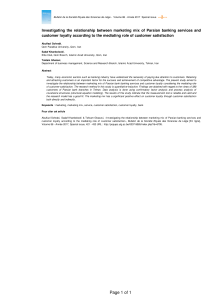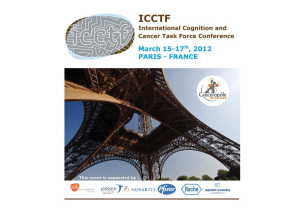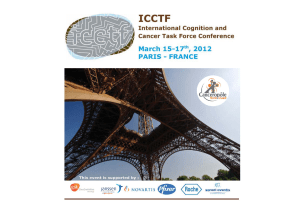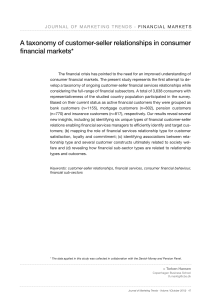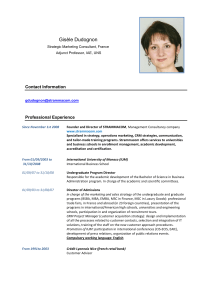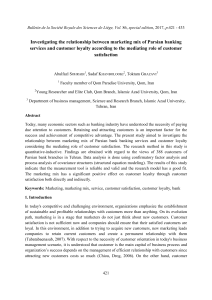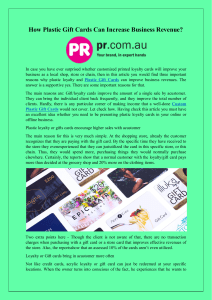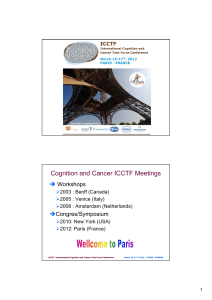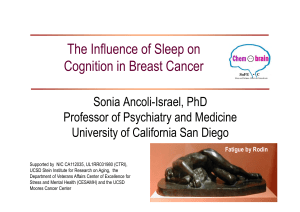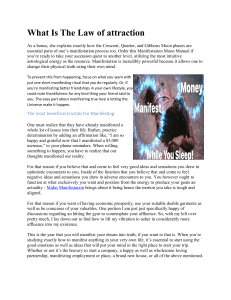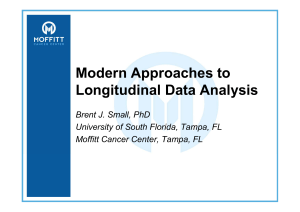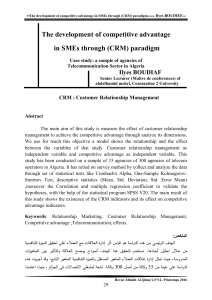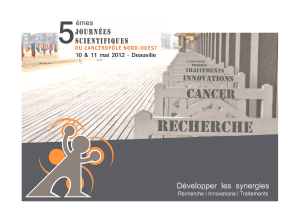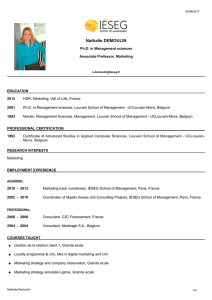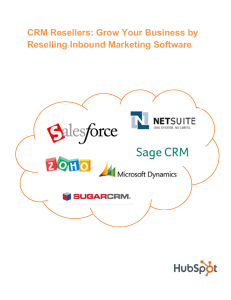Impact of traditional marketing practices and relationship marketing
publicité
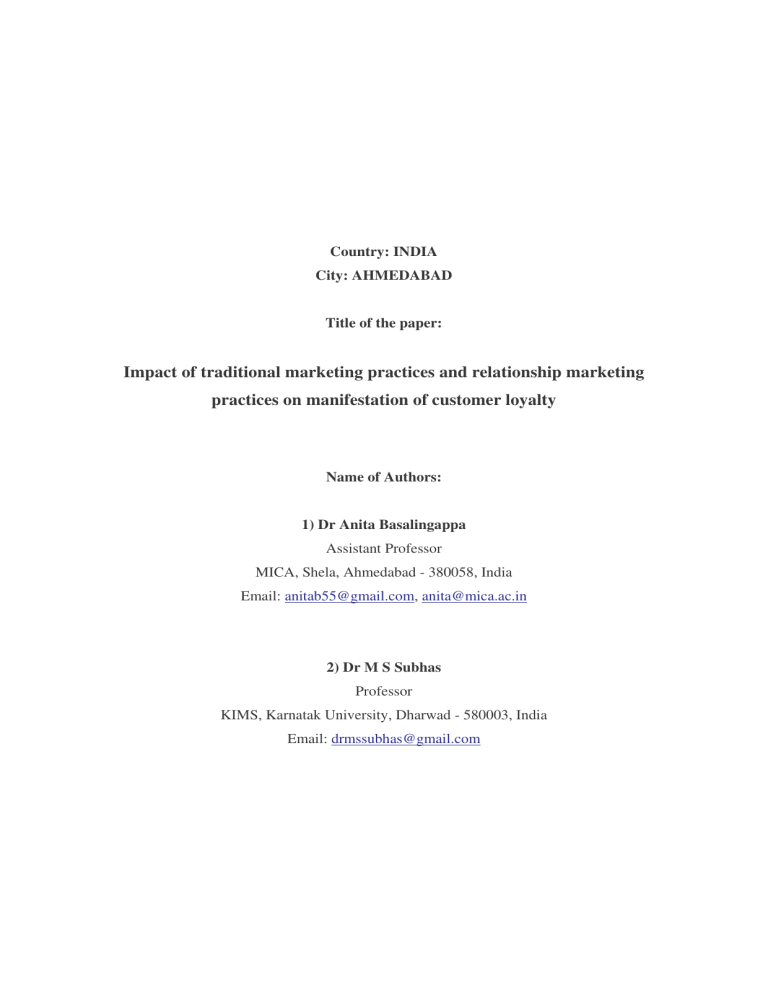
Country: INDIA City: AHMEDABAD Title of the paper: Impact of traditional marketing practices and relationship marketing practices on manifestation of customer loyalty Name of Authors: 1) Dr Anita Basalingappa Assistant Professor MICA, Shela, Ahmedabad - 380058, India Email: [email protected], [email protected] 2) Dr M S Subhas Professor KIMS, Karnatak University, Dharwad - 580003, India Email: [email protected] Impact of traditional marketing practices and relationship marketing practices on manifestation of customer loyalty Abstract: This paper presents the process of manifestation of customer loyalty across attitudinal stages and action stage under traditional marketing practices and relational marketing practices. The study has been conducted across four sectors – financial institution, bank, automobile dealer and cellular service provider in South India. LISREL 8.54 version was used to test the proposed models based on 333 respondents. The results indicate formation of attitudinal loyalty under traditional marketing practices, whereas the formation of attitudinal loyalty is through action stage with intervention of relational marketing practices. Key words: Relationship marketing, Customer loyalty Introduction Building customer loyalty is the ultimate objective of every marketing activity given the fierce competition for a larger share of customers’ wallet. Studies have cited development of customer loyalty through attitudinal and behavioral stages (Dick and Basu, 1994; Oliver, 1999; Randall, 2000; Sasser and Jones, 1995; Jacoby and Kyner, 1973; Aaker, 1991; Assael, 1998; Day, 1969). But none of the studies have empirically tested the impact of traditional marketing practices and relational marketing practices on the manifestation of customer loyalty across cognition, affect, conation and action stages. Customer loyalty has been one of the main objectives of marketing strategy. Every marketing strategy aims to acquire customers and retain them. Competition had a boundary prior to the information technology phase. With the information economy boom, the boundaries have become seamless and competition more intense and the challenges have been thrown open to customer’s choice. Retaining loyal customers has 1 become paramount. Customer retention which is often seen as synonymous with customer loyalty (Boulding, et al., 1993) has been the focus for CRM. Customer acquisition costs are much higher than customer retention costs. Retaining customers over a period of time without customer loyalty is not profitable. Building loyalty through customer retention strategies makes profit sense. CRM is viewed as a customer retention tool in which a variety of post purchase tactics are used for customer bonding or staying in touch after the sale is made (Vavra, 1992). Given the commonality of profitable retention of customers as an objective among marketing strategies, it is required to empirically test the advantages of CRM as a retention tool over traditional marketing practices. This study tests the manifestation of loyalty with and without CRM tools in the marketing decisions. The marketing decisions without CRM tools are termed ‘traditional marketing practices’ in this paper. Literature Review Literature has shown relationship marketing as an emerging concept given the competitive scenario coupled with convergence of technology and communication. Relationship marketing has been established to impact the top line and bottom line positively by retaining customers. There is no study that empirically tests the advantage of CRM over traditional marketing practice as a tool for building customer loyalty. In this paper traditional marketing practices are defined as marketing decisions that comprise of product policy, pricing, advertising and distribution targeted at specific market segments without formal CRM strategies. Traditional marketing practices aimed at achieving customer loyalty through availability, better price, product and communicating to the customer. Customer loyalty manifests itself across attitudinal and behavioral stages (Oliver 1999). Hence the first research objective is to test the manifestation of customer loyalty with traditional marketing practices across attitudinal stages - cognition, affect, conation and behavioral stage action. 2 Research Objective 1 (RO1): To test the manifestation of customer loyalty across cognition, affect, conation and action stages with traditional marketing practices. The proposed conceptual structural path model for manifestation of customer loyalty across cognition, affect, conation and action stages is as in Figure 1. Figure 1: Proposed conceptual structural path model for manifestation of customer loyalty across cognition, affect, conation and action stages Figure 2: Hypotheses for manifestation of customer loyalty across cognition, affect, conation and action stages RO1H1: Cognition positively influences affect. RO1H2: Cognition positively influences conation. RO1H3: Cognition positively influences action. RO1H4: Affect positively influences conation. RO1H5: Affect positively influences action. RO1H6: Conation positively influences action. The fundamental purpose of Customer Relationship Management (CRM) has been to understand and serve buyers better. For a relationship to be sustainable or build loyalty, buyers must find value in the company’s offerings. This value can come about in a number of ways. For example, a Hair dresser may take responsibility for identifying 3 exactly what the customer seeks, rather than leaving it to the customer to have to specify the style. To develop such an ability to solve problems jointly, trust between the buyer and the seller forms the basis. Building of relationship between the buyer and seller will mean connecting with the buyer emotionally and rationally. CRM is often seen as synonymous with relationship marketing (Sheth and Parvatiyar, 1995). Definitions of CRM and relationship marketing in literature support the commonality in dealing with both the terms synonymously. For example, “Relationship marketing is a strategy to attract, maintain and enhance customer relationships” (Berry 1983) and “Activities an enterprise performs to identify, select, acquire, develop and retain increasingly loyal and profitable customers” (Galbreath 1998). Hence this study will treat the terms CRM and relationship marketing as equivalent constructs and will be used synonymously. Customer loyalty is identified as one of the main objectives of customer relationships. Cuthbertson (2003) provides an insight into the role of CRM within loyalty marketing. CRM activities may be very effective in enhancing customer loyalty for profit. This can only be achieved through understanding the relevance of such tools and techniques to the overall loyalty marketing strategy and applying them accordingly. The need to generate behavioral loyalty has been identified as one of the major drivers for implementing CRM systems (Ryals, 2003). There is relatively little research on attitudinal loyalty and CRM. With the bulk of the research conducted so far has been focused on behavioral loyalty. The emphasis on behavioral loyalty has led to CRM being used to develop behavioral loyalty strategies (Winer, 2001). Most research in the CRM area emphasizes behavioral loyalty and neglects the attitudinal components of loyalty (Chaudhuri, 2001). Specifically research has relatively very little done in the area of role of CRM across attitudinal and behavioral loyalty. Hence the second research objective is to test if relationship marketing can influence manifestation of attitudinal loyalty leading to behavioral loyalty. 4 Research Objective 2 (RO2): To study the role of relationship marketing in the manifestation of customer loyalty across cognition, affect, conation and action stages. Based on the existing literature, businesses can build customer relationships by initiating one or several types of bonds. Berry and Parasuraman (1991) have described financial bonds, social bonds, customization bonds and structural bonds as tools that can be used to build relationships to retain customers. CRM in this study is viewed as a relational tool. Role of CRM is explained by using financial bonds, social bonds and customization bonds. The proposed conceptual structural path model for role of CRM in manifestation of customer loyalty across cognition, affect, conation and action stages is in Figure 2 Figure 3: Proposed conceptual structural path model for role of CRM in manifestation of customer loyalty across cognition, affect, conation and action stages. 5 Figure 4: Hypotheses for role of CRM in manifestation of customer loyalty across cognition, affect, cognition and action stages RO3H1: RO3H2: RO3H3: RO3H4: RO3H5: RO3H6: RO3H7: RO3H8: RO3H9: RO3H10: RO3H11: Financial bonds positively influence cognition. Financial bonds positively influence affect. Financial bonds positively influence conation. Financial bonds positively influence action. Social bonds positively influence cognition. Social bonds positively influence affect. Social bonds positively influence conation. Social bonds positively influence action. Customization bonds positively influence cognition. Customization bonds positively influence affect. Customization bonds positively influence conation. 6 RO3H12: RO3H13: RO3H14: RO3H15: RO3H16: RO3H17: RO3H18: Customization bonds positively influence action. Cognition positively influences affect. Cognition positively influences conation. Cognition positively influences action. Affect positively influences conation. Affect positively influences action. Conation positively influences action. Method Data Collection Churchill (1979) methodology was followed in arriving at the questionnaires. Twenty four hypotheses were tested based on consumer samples across four sectors. The number of effective responses was three hundred and thirty three of the total fourteen hundred questionnaires administered – twenty four percent hit rate. This is a survey-based research done across four sectors as in ‘Table 1: Sample size details.’ Table 1: Sample size details Sectors Automobiles Telecom Banks Financial Institution Total Number of firms in each sector surveyed to be surveyed 7 4 8 7 Number of respondents from each firm to be surveyed 200*2 200*3 100*2 100*2 101 Total number of respondents from each sector to be surveyed 400 600 200 200 1400 Measures The multiple item scales (See Appendix for Operationalisation of variables) were assessed by calculating the Cronbach Alpha coefficient. Cronbach Alpha coefficient is a model of internal consistency of the scale, based on the average inter-item correlation with a value of 0.7 being used as a cut off for an item to be included in a scale (Nunnally, 7 1987). These multiple item measures were also factor analyzed to ensure that they loaded on the right factor. Each of the conceptualized comprehensive models is a simultaneous system of equations having latent constructs and multiple indicators. LISREL 8.54 version software was used for testing relationships in the proposed model. This required the construction of the measurement model to test the reliability and validity of the multiple item measures of the constructs. Structural equation model was proposed to specify the causal relationship among the latent variables. The proposed structural model for RO1 has three endogenous (dependent) constructs and one exogenous (independent) construct. The endogenous constructs are affect, conation and action. Cognition is the only exogenous construct. All the four constructs have multiple indicators (See Figure 1 and Appendix C). The proposed structural model for RO2 has four exogenous (independent) constructs and three endogenous (dependent) constructs. The endogenous constructs are cognition, affect, conation and action. The exogenous constructs are social bonds, financial bonds and customization bonds. All the seven constructs have multiple indicators (See Figure 3 and Appendix C). Findings Research Objective 1: In fitting the model to the data, there were no convergence problems or offending estimates. The detailed estimates, model fit indices, t-values of the final model are placed in ‘Figure 7: Full model for manifestation of customer loyalty across cognition, affect, conation and action stages with traditional marketing practices’. The constructs are represented by circles and the observed items are represented in rectangles. The arrows from each construct to the rectangles indicate the number of supporting observed variables. The numbers on the arrows between each circle and rectangle indicate the parameter estimates of the measurement model. The standardized coefficients and tvalues for six hypothesized paths are available in ‘Table 2: Results of the tested hypotheses for interrelationships among constructs for manifestation of customer loyalty 8 across cognition, affect, conation and action stages with traditional marketing practices’. Four hypotheses – RO1H1, RO1H2, RO1H4 and RO1H6 have strong support as shown in ‘Figure 5: Structural model for manifestation of customer loyalty across cognition, affect, conation and action stages with traditional marketing practices’. RO1H5 has partial support in that sign of the estimate is in the expected direction. RO1H3 has no support. Each of the constructs has a direct and an indirect impact on the other. The effects and their decomposition are in ‘Table 3: Effect Decomposition among constructs for manifestation of customer loyalty across cognition, affect, conation and action stages with traditional marketing practices’. Cognition has forty one percent indirect effect on action. This is explained by the direct effect of cognition on affect and conation which is sixty eight percent and eighty five percent respectively. All the hypothesized relationships have full support or partial support. The R² values explain variance for affect, conation and action are fifty eight percent, eighty one percent, thirty one percent and eighty percent respectively as in ‘Table 4: Structural equations for manifestation of customer loyalty model across cognition, affect, conation and action stages with traditional marketing practices’. The variance indicates the predictability of the constructs. The point estimate of root mean square error of approximation (RMSEA) is below 0.061. The P-value for test of close fit is 0.0019. Another indication that the model fits well is that the expected cross validation index (ECVI) for the model (2.66) is almost nearing (if not lesser than) the ECVI for the saturated model (2.45). The confidence interval for ECVI is from 2.45 to 2.89. Hence it can be concluded that the model fits well and represents a reasonably close approximation. 9 Figure 5: Structural model for manifestation of customer loyalty across cognition, affect, conation and action stages with traditional marketing practices Table 2: Results of the tested hypotheses for manifestation of customer loyalty across cognition, affect, conation and action stages with traditional marketing practices RO1 Link H1 CognitionAffect CognitionConation CognitionAction AffectConation AffectAction ConationAction H2 H3 H4 H5 H6 Expected Sign + Standardized Estimate 0.68 T-value Result 9.04 + 0.47 6.86 + 0.09 0.72 Full support: sign as well as estimate Full support: sign as well as estimate Partial support + 0.55 6.86 + 0.20 1.30 Full support: sign as well as estimate Partial support + 0.33 1.63 Partial support 10 Table 3: Effect Decomposition among constructs for manifestation of customer loyalty across cognition, affect, conation and action stages with traditional marketing practices Construct Effect on Affect Effect on Conation Effect on Action Effect Direct Indirect Total Direct Indirect Total Direct Indirect Total Cognition 0.68 0.68 0.85 0.38 1.23 0.50 0.41 0.91 Table 4: Structural equations for manifestation of customer loyalty model across cognition, affect, conation and action stages with traditional marketing practices affect = 0.68*cognition, Errorvar.= 0.54 , R² = 0.46 (0.075) (0.097) 9.04 5.53 conation = 0.55*affect + 0.47*cognition, Errorvar.= 0.11 , R² = 0.89 (0.081) (0.069) (0.027) 6.86 6.86 4.22 action = 0.20*affect + 0.33*conation + 0.087*cognition, Errorvar.= 0.66 , R² = 0.34 (0.15) (0.20) (0.12) (0.12) 1.30 1.63 0.72 5.37 In parentheses are the standard error values and below the parentheses are the t-values Research Objective 2 In fitting the model to the data, there were no convergence problems or offending estimates. Detailed estimates, model fit indices, t-values are placed in ‘Figure 8: Full model of path analysis for role of CRM in building customer loyalty across cognition, affect, conation and action stages’. The standardized coefficients and t-values for eighteen hypothesized paths are available in ‘Table 5: Results of the tested hypotheses for role of CRM in building customer loyalty’. 11 Figure 6: Structural model for role of CRM in building customer loyalty across cognition, affect, conation and action stages Table 5: Results of the tested hypotheses for role of CRM in building customer loyalty across cognition, affect, conation and action stages RO3 Link H1 Financial bonds Cognition Financial + bonds - Affect H2 H3 H4 Financial bonds Conation Financial bonds Action Expected Sign + - Standardized Estimate -0.10 Tvalue -1.59 0.15 1.76 + 0.03 0.44 + 0.14 1.73 12 Result No support: neither sign nor estimate as per expectation Partial support: sign as per prior expectation Partial support: sign as per prior expectation Partial support: sign as per prior expectation H5 H6 Social bonds - + Cognition Social bonds - + Affect 0.44 7.11 -0.37 -3.53 Full support: sign as well as estimate Partial support: sign not as per prior expectation No support: neither sign nor estimate as per expectation No support: neither sign nor estimate as per expectation Full support: sign as well as estimate H7 Social bonds - + Conation -0.15 -1.90 H8 Social bonds - + Action -0.04 -0.52 H9 Customized + bonds Cognition Customized + bonds - Affect 0.61 7.12 0.04 0.22 + 0.32 3.33 + 0.15 1.16 - + 0.90 4.81 - + 0.37 2.52 0.39 5.37 Full support: sign as well as estimate No support 0.35 3.57 Full support: sign as well as estimate H10 H11 H12 H13 H14 H15 H16 H17 H18 Customized bonds Conation Customized bonds Action Cognition Affect Cognition Conation Cognition Action Affect Conation Affect Action Conation Action - - + - + - + - + Partial support: sign as per prior expectation Full support: sign as well as estimate Partial support: sign as per prior expectation Full support: sign as well as estimate Full support: sign as well as estimate No support Seven hypotheses – RO3H5, RO3H9, RO3H11, RO3H13, RO3H14, RO3H16 and RO3H18 have strong support as shown in ‘Figure 6: Structural model for role of CRM in building customer loyalty across cognition, affect, conation and action stages’. RO3H2, RO3H3, RO3H4, RO3H6, RO3H10 and RO3H12 have found partial support. The sign of the estimate is in the expected direction. RO3H1, RO3H7, RO3H8, RO3H15 and RO3H17 have no support. 13 Here the point estimate of RMSEA is below 0.057. The P-value for test of close fit is 0.00. Another indication that the model fits well is that the ECVI for the model (13.77) is almost nearing (if not lesser) the ECVI for the saturated model (13.32). The confidence interval for ECVI is from 13.24 to 14.34. Hence it can be concluded that the model fits well and represents a reasonably close approximation. All the fit indices are between 0 and 1 indicating a good fit for the model. The effects and their decomposition are in ‘Table 6: Effect Decomposition for role of CRM in building customer loyalty across cognition, affect, conation and action stages’. Financial bonds do not seem to have direct or indirect effect on loyalty stages in this study. Social bonds have a forty percent effect on the construct affect and a direct effect of forty four percent on cognition. Social bonds do not have a significant effect direct or indirect on conation stage and action stage. Customization bonds has sixty one percent direct effect on cognition, fifty eight percent effect on the construct affect, seventy seven percent effect on conation and forty two percent effect on action. Customization bonds have indirect effects on the constructs affect, conation and action. The indirect effects are fifty five percent on affect, forty six percent on conation and twenty seven percent on action. The results have shown that customization bonds have a strong role in building customer loyalty through cognition, affect, conation and action stages and social bonds impact the attitude formation stages. The variance R² explained for cognition, affect, conation and action are 58%, 81%, 31%, and 80% respectively as in ‘Table 7: Structural equations for role of CRM in building customer loyalty across cognition, affect, conation and action stages’. The predictability of the constructs affect and action are very high and that of cognition is moderate. 14 Table.6: Effect decomposition for role of CRM in building of customer loyalty across cognition, affect, conation and action stages Construct Effect Cognition Effects on Direct Effect on Affect Effect on Conation Effect on Action Indirect Total Direct Indirect Total Direct Indirect Total Direct Indirect Total Financial bonds -0.10 Social bonds 0.44 Customization bonds 0.61 -0.10 0.06 -0.09 -0.03 0.01 -0.01 0.00 0.15 0.00 0.15 0.44 0.03 0.40 0.43 0.03 0.17 0.20 -0.03 0.01 -0.02 0.61 0.58 0.55 1.13 0.77 0.46 1.23 0.42 0.27 0.69 Table 7: Structural equations for role of CRM in building customer loyalty across cognition, affect, conation and action stages affect = 0.90*cognition + 0.15*financial - 0.37*social + 0.032*customsd, Errorvar. = 0.42 , R² = 0.58 (0.19) (0.084) (0.10) (0.15) (0.084) 4.81 1.76 -3.53 0.22 4.94 conation = 0.39*affect + 0.37*cognition + 0.025*financial - 0.15*social + 0.32*customsd, Errorvar.= 0.19 , R² = 0.81 (0.072) (0.15) (0.056) (0.077) (0.096) (0.031) 5.37 2.52 0.44 -1.90 3.33 6.15 action = 0.35*conation + 0.14*financial - 0.036*social + 0.15*customsd, Errorvar.= 0.69 , R² = 0.31 (0.097) (0.083) (0.070) (0.13) (0.11) 3.57 1.73 -0.52 1.16 6.20 cognition = - 0.100*financial + 0.44*social + 0.61*customsd, Errorvar.= 0.20 , R² = 0.80 (0.063) (0.061) (0.086) (0.041) -1.59 7.11 7.12 4.84 In parentheses are the standard error values and below the parentheses are the t-values 15 Conclusions This study proves that CRM is a tool that builds customer loyalty from attitudinal stages through behavioral stage. Without CRM, manifestation of customer loyalty does not transcend from attitudinal stages to behavioral stage. Literature has shown that traditional marketing strategies lead to formation of behavioral loyalty and not necessarily build attitudinal loyalty. The missing link between attitudinal and behavioral loyalty justifies and supports formation of behavioral loyalty without attitudinal loyalty. Customers were being loyal behaviorally without being loyal attitudinally as traditional marketing practices were not sufficient to lead the attitudinal loyalty to behavioral stage. Relational bonds impact customer loyalty from attitudinal stages through behavioral stage. This study has proved that social bonds and customization bonds support manifestation of customer loyalty which leads to behavioral loyalty. The results support the studies that have revealed that customers in service industries are realizing the benefits of entering into relationships. The results also indicate that the nurturing of relationships using relational bonds lead to loyal customers. Based on type of business, customer relationships can by initiated using one or more types of relational bonds. Customers groups subjected to social, financial and customization benefits have a long-term relationship with the service provider. Therefore relationship performance has a definite role in building customer loyalty. In this research study across financial institution, bank, telecom and auto sectors, it is observed that a strong, direct, and a positive impact existed between social bonds and cognition stage; customization bonds and conation stage; and conation stage and action stage with intervention of relational bonds. Managerial implications The focus of relationship marketing on establishing and enhancing a long-term, mutually beneficial relationship between the consumer and the marketer is supported by the results 16 of this research. The role of relationship marketing in manifestation of customer loyalty across attitudinal and behavioral loyalty can be used to weave CRM practices and customer loyalty programs. Such relationship practices will ensure that the marketer is oriented toward customer retention and the development of a unique relationship with each individual customer, involving the customer in the design, development, and marketing processes of the company. Consequently, relationship marketing is likely to make marketing practices more effective because, on the one hand, the individual consumer’s needs are better addressed, and, on the other, consumer involvement in the development of marketing processes and practices leads to greater consumer commitment to the marketer’s programs. Relationship marketing practices in consumer markets will grow in the future. Consumers have always been interested in relationships (that are non intrusive) with marketers. Marketer-initiated approaches to relationship marketing will become more prevalent and their frequency will rise sharply. Technological advances are making it possible and affordable for marketers to engage in and maintain relationships with customers. Marketers now have both the willingness and ability to engage in relationship marketing. The willingness has come from enlightened self-interest and the understanding that customer retention is economically more advantageous than constantly seeking new customers. The ability to engage in relationship marketing has developed primarily because of technological advances that are facilitating the process of engaging in and managing relationships with individual customers. The results of this study will help strategize relationship marketing to ensure attitudinal loyalty and not just behavioral loyalty. Loyalty marketing has been a popular topic among marketers. The Direct Marketing Association, the world’s largest and foremost organization for direct marketing professionals, reports that the most heavily attended sessions at their annual conference and exhibition in 1997 were those sessions described as customer relationship management (Duffy, 1998). Marketers are searching for insight, solutions, examples and guidance. The problems they seek to solve are all the same: improve customer retention and maximize share of customer. The results of the study can be extended to service markets with credence and experience based consumer buying. Companies can be guided 17 on investing in relational bonds to build loyalty from attitudinal stages through behavioral stage. 18 References Assael, H. (1998), Managing Brand Equity: Consumer Behavior and Market Action, South-Western, Cincinnati, OH. Aaker, David A. (1991), Managing Brand Equity: Capitalizing on the Value of a Brand Name, New York: The Free Press. Berry, L.L. (1983), “Relationship Marketing”, in Emerging Perspectives on Services Marketing, L.L. Berry, G.L.Shostack and G. D. Upah, eds. Chicago, American Marketing Association, 25-28. Berry, L. L. and Parasuraman, A. (1991a), in Services Marketing, Zeithaml, Valarie. and M.J. Bitner (eds), New York, McGraw-Hill. Chaudhuri, Arjun; Holbrook, Morris B. (2001), “The Chain of Effects from Brand Trust and Brand Affect to Brand Performance: The Role of Brand Loyalty,” Journal of Marketing, Vol. 65 Issue 2, p81, 13p. Churchill, G.A., Jr, (1979), “A Paradigm for Developing Better Measures of Marketing Constructs,” Journal of Marketing Research, 36(l), 64-73. Cuthbertson, Richard and Laine Arttu (2003), “The role of CRM within retail loyalty marketing,” Journal of Targeting, Measurement and Analysis for Marketing,12(3), 290– 304. Day, George S. (1969), “A Two-Dimensional Concept of Brand Loyalty,” Journal of Advertising Research, 9, 29-35. Dick, Alan S. and Basu, Kunal (1994), “Customer Loyalty: Towards an Integrated Framework”, Journal of The Academy of Marketing Science, 22 (2), 99-113. 19 Duffy, Dennis L. (1998), “Customer loyalty strategies,” Journal of Consumer Marketing, 15(5), 435-448. Galbreath, J. (1998) quoted in, “The role of CRM within retail loyalty marketing,” Journal of Targeting, Measurement and Analysis for Marketing, Cuthbertson, Richard, & Laine Arttu, 12(3), 290–304. Jacoby, Jacob and David B. Kyner (1973), “Brand Loyalty Vs. Repeat Purchasing Behavior,” Journal of Marketing Research, 10, (February), 1-9. Jones, Thomas O. and N. Earl Sasser Jr (1995), “Why Satisfied Customers Defect”, Harvard Business Review, 73 (November/ December), 88-99. Joreskog, Karl G. and Dag Sorbom (1996). LISREL 8: User’s Reference Guide. Chicago, IL: Scientific Software International. McMullan, Rosalind and Gilmore, Audrey (2003), “The conceptual development of customer loyalty measurement: A proposed scale,” Journal of Targeting, Measurement and Analysis for Marketing, 11(3), ABI/INFORM Global pg. 230. Nunnally, J.C. (1967), Psychometric Theory, New York, McGraw-Hill. Oliver, Richard L. (1999), “Whence Consumer Loyalty?” Journal of Marketing, Special Issue, Vol. 63 Issue 4, p33, 12p Randall Brandt D (2000), Marketing News (August 14) Ryals, L. (2003), “Creating profitable customers through the magic of data mining,” Journal of Targeting, Measurement and Analysis for Marketing, 11(4), p.343. 20 Sheth, J. N. and Parvatiyar, A. (1995), “The Evolution of Relationship Marketing,” International Business Review, 4, 397-418. Vavra, T. G. (1992) quoted in Handbook of Relationship Marketing, Sheth J. N. and Parvatiyar, A., eds. Sage Publications, New Delhi. Wilson, David T. (1995), “An Integrated Model of Buyer- Seller Relationships,” Journal of the Academy of Marketing Science, 23 (Fall), 335-45. Winer, R. (2001), “A framework for customer relationship management,” California Management Review, 43(4), 89–107. 21 APPENDIX A Figure 7: Full model of path analysis for manifestation of customer loyalty across cognition, affect, conation and action stages (Refer to item code description in AppendixC: Operationalization of variables) 22 APPENDIX B Figure 8: Full model of path analysis for role of CRM in building customer loyalty across cognition, affect, conation and action stages (Refer to item code description in Appendix C: Operationalization of variables) 23 APPENDIX C: Operationalization of variables for the first research objective Construct Cognition Affect Conation Generation of items in each construct The initial set of items were based on McMullan (2003) and redone based on in-depth interviews with customers The initial set of items were based on McMullan (2003) and redone based on in-depth interviews with customers The initial set of items were based on McMullan (2003) and redone based on in-depth Number of items in each construct 5 4 10 Measures Item code in path analysis 1. I understand the features of XYZ product/ service product/ services well enough to evaluate it against other product/ services. 2. It is important that when choosing to buy a product/ service, I make the right choice of product/ service. 3. XYZ product/ service is a product/ service that interests me. 4. When deciding on a product/ service I am not interested in bargain-seeking. 5. XYZ product/ service is visually appealing. 1. When choosing a product/ service, I compare prices of different product/ services to be sure I get the best value for money. 2. When I see an alternative product/ service somewhat different than the usual, I investigate it. 3. When I am to buy a product/ service, I feel safer to buy the one I am familiar with. 4. If I like a product/ service, I rarely switch from it just to try something different. 1. XYZ product/ service has up to date equipment. 2. XYZ product/ service is exactly what I need from a product/ service. 3. I truly have enjoyed XYZ product/ service. 24 cognito VAR1_1 VAR2_1 VAR3_1 VAR4_1 VAR7_1 affect VAR5_1 VAR20_1 VAR26_1 Scale 7 point scale 7: strongly agree, 1: strongly disagree 7 point scale 7: strongly agree, 1: strongly disagree VAR27_1 conation VAR6_1 VAR8_1 VAR11_1 VAR13_1 7 point scale 7: strongly agree, 1: strongly interviews with customers Action The initial set of items were based on McMullan (2003) and redone based on in-depth interviews with customers 4. XYZ product/ service is a product/ service that I could talk about for a long time. 5. I have a preference for XYZ product/ service in this locality. 6. XYZ product/ service is more than a mere product/ service. 7. I would buy XYZ product/ service if I have to buy a product/ service again or exchange. 8. Owning/ using XYZ product/ service say a lot about who I am. 9. I care a lot about XYZ product/ service. 10. I consider myself to be highly loyal to XYZ product/ service. 9 1. XYZ product/ service as a choice of product/ service has not worked out well as I thought it would. 2. If I could do it over again, I will choose an alternative product/ service to XYZ product/ service. 3. Product/ service staff should not be expected to give customers individual attention. 4. I would try an alternative product/ service if it was 25% less expensive than XYZ product/ service. 5. I would try an alternative product/ service if the alternative product/ service increased facilities than XYZ product/ service. 6. I would change the product/ service if the alternative offered increased status. 7. I would change product/ service if the alternative product/ service staff were friendlier. 8. I would get tired of XYZ product/ service for all my life. 9. I get bored with buying the same brands even if it is good. 25 VAR14_1 VAR15_1 VAR21_1 disagree VAR22_1 VAR23_1 VAR24_1 action VAR9_1 VAR10_1 VAR12_1 VAR16_1 VAR17_1 VAR18_1 VAR19_1 VAR25_1 VAR28_1 7 point scale 7: strongly agree, 1: strongly disagree Operationalization of variables for the second research objective Construct Social bonds Generation of items in each construct The initial set of items were based on based on Wilson’s (1995) list of extended variables that explain buyerseller relationships and in-depth interviews with business establishments and customers Number of items in each construct 14 Measures 1. I am interested in visiting XYZ PRODUCT/ SERVICE because it is visually appealing. 2. I use services of XYZ PRODUCT/ SERVICE because of high status 3. In future I intend to use services of XYZ PRODUCT/ SERVICE because of the individual attention and care 4. I intend to use services of XYZ PRODUCT/ SERVICE because it would feel good status-wise. 5. I like using services of XYZ PRODUCT/ SERVICE because of the experience I have had before. 6. I like using the services of XYZ PRODUCT/ SERVICE because of the value for money services & products I get at XYZ PRODUCT/ SERVICE. 7. I like using services of XYZ PRODUCT/ SERVICE because their office is spacious and it feels good to spend time in XYZ PRODUCT/ SERVICE. 8. I have decided to use services of XYZ PRODUCT/ SERVICE henceforth because of the value for money services and products available at XYZ PRODUCT/ SERVICE. 9. I have decided to use services of XYZ PRODUCT/ SERVICE henceforth because its office is spacious and it feels good to spend time in XYZ PRODUCT/ SERVICE. 10. In future I will use services of XYZ PRODUCT/ SERVICE only because of convenience and not because of anything 26 Item code in path analysis social V4_1 V13_1 V16_1 V17_1 V18_1 V20_1 V21_1 V22_1 V23_1 V24_1 V25_1 V26_1 Scale 7 point scale 7: strongly agree, 1: strongly disagree Financial bonds The initial set of items were based on based on Wilson’s (1995) list of extended variables that explain buyerseller relationships and in-depth interviews with business establishments and customers else. 11. At present I use services of XYZ PRODUCT/ SERVICE because of convenience and not because of any other reason. 12. In future I will use services of XYZ PRODUCT/ SERVICE because of ease of parking space near their office. 13. At present I use services of XYZ PRODUCT/ SERVICE because of ease of parking space. 14. I use services of XYZ PRODUCT/ SERVICE because the service at XYZ PRODUCT/ SERVICE is extremely convenient to my lifestyle (Reminders are sent, personalized service) 11 1. I got to know more about XYZ PRODUCT/ SERVICE after I have started using services of XYZ PRODUCT/ SERVICE and hence I am keen on availing this service. 2. I have been using services of XYZ PRODUCT/ SERVICE because of the low Cost of Services, visual pleasure and new concept/ product/ service. 3. As a matter of requirement I have been using services of XYZ PRODUCT/ SERVICE and will continue the same. 4. In future I will definitely use services of XYZ PRODUCT/ SERVICE because of the attitude of the employees towards me. 5. I have a positive feeling toward XYZ PRODUCT/ SERVICE because of the attitude of the employees towards me. 6. I will definitely use services of XYZ PRODUCT/ SERVICE because of the benefits I get from XYZ PRODUCT/ SERVICE. 7. I have a positive feeling towards XYZ PRODUCT/ SERVICE because of the benefits I get from XYZ PRODUCT/ SERVICE. 8. I am interested in XYZ PRODUCT/ SERVICE because of the new schemes and benefits I get. 27 V27_1 V28_1 financia V3_1 V5_1 V6_1 V7_1 V8_1 V9_1 V10_1 V11_1 V12_1 V14_1 V15_1 7 point scale 7: strongly agree, 1: strongly disagree Customization bonds The initial set of items were based on Wilson’s (1995) list of extended variables that explain buyerseller relationships and in-depth interviews with business establishments and customers 9. I tend to use services more from XYZ product/ service because of the financial benefits and gains. 10. I use services of XYZ PRODUCT/ SERVICE because of individual attention and care I receive. 11. I intend to use services of XYZ PRODUCT/ SERVICE because of the financial benefits. 13 1. The benefits that one gets by using services of XYZ PRODUCT/ SERVICE distinguish it from other alternatives. 2. The benefits that one gets by using services of XYZ PRODUCT/ SERVICE helps in understanding the differences between the various alternatives. 3. I will definitely use services of XYZ PRODUCT/ SERVICE because of the benefits that I get from XYZ PRODUCT/ SERVICE. 4. I am willing to travel or shift from the existing alternate service to use services of XYZ PRODUCT/ SERVICE because of the kind of relationship that XYZ PRODUCT/ SERVICE maintains with the customers. 5. I have been using services of XYZ PRODUCT/ SERVICE because of the relationship that is extended to me and the benefits that I get. 6. I understand the various features of various products and services because of XYZ PRODUCT/ SERVICE. 7. I buy from XYZ PRODUCT/ SERVICE because… I understand the utility of this product/service. 8. I understand how XYZ PRODUCT/ SERVICE is different from others. 9. I have decided to use services of XYZ PRODUCT/ SERVICE. 10. I intend to use services of XYZ PRODUCT/ SERVICE because… I understand the utility of this product/ service. 11. I understand how XYZ PRODUCT/ SERVICE is different from others. 28 customsd V29_1 V30_1 V31_1 V32_1 V33_1 V34_1 V35_1 V36_1 V37_1 V38_1 V39_1 V40_1 V19_1 7 point scale 7: strongly agree, 1: strongly disagree Cognition Affect Conation The initial set of items were based on McMullan (2003) and redone based on in-depth interviews with customers The initial set of items were based on McMullan (2003) and redone based on in-depth interviews with customers The initial set of items were based on McMullan (2003) and redone based on in-depth interviews with 12. I have been using services of XYZ PRODUCT/ SERVICE and I enjoy the experience. 13. I have decided to use services of XYZ PRODUCT/ SERVICE henceforth because the first experience at XYZ PRODUCT/ SERVICE was good. 5 4 10 1. I understand the features of XYZ product/ service product/ services well enough to evaluate it against other product/ services. 2. It is important that when choosing to buy a product/ service, I make the right choice of product/ service. 3. XYZ product/ service is a product/ service that interests me. 4. When deciding on a product/ service I am not interested in bargain-seeking. 5. XYZ product/ service is visually appealing. 1. When choosing a product/ service, I compare prices of different product/ services to be sure I get the best value for money. 2. When I see an alternative product/ service somewhat different than the usual, I investigate it. 3. When I am to buy a product/ service, I feel safer to buy the one I am familiar with. 4. If I like a product/ service, I rarely switch from it just to try something different. 1. XYZ product/ service has up to date equipment. 2. XYZ product/ service is exactly what I need from a product/ service. 3. I truly have enjoyed XYZ product/ service. 4. XYZ product/ service is a product/ service that I could talk about for a long time. 5. I have a preference for XYZ product/ service in this locality. 29 cognito VAR1_1 VAR2_1 VAR3_1 VAR4_1 VAR7_1 affect VAR5_1 VAR20_1 VAR26_1 7 point scale 7: strongly agree, 1: strongly disagree 7 point scale 7: strongly agree, 1: strongly disagree VAR27_1 conation VAR6_1 VAR8_1 VAR11_1 VAR13_1 VAR14_1 VAR15_1 VAR21_1 7 point scale 7: strongly agree, 1: strongly disagree customers Action The initial set of items were based on McMullan (2003) and redone based on in-depth interviews with customers 6. XYZ product/ service is more than a mere product/ service. 7. I would buy XYZ product/ service if I have to buy a product/ service again or exchange. 8. Owning/ using XYZ product/ service say a lot about who I am. 9. I care a lot about XYZ product/ service. 10. I consider myself to be highly loyal to XYZ product/ service. 9 1. XYZ product/ service as a choice of product/ service has not worked out well as I thought it would. 2. If I could do it over again, I will choose an alternative product/ service to XYZ product/ service. 3. Product/ service staff should not be expected to give customers individual attention. 4. I would try an alternative product/ service if it was 25% less expensive than XYZ product/ service. 5. I would try an alternative product/ service if the alternative product/ service increased facilities than XYZ product/ service. 6. I would change the product/ service if the alternative offered increased status. 7. I would change product/ service if the alternative product/ service staff were friendlier. 8. I would get tired of XYZ product/ service for all my life. 9. I get bored with buying the same brands even if it is good. 30 VAR22_1 VAR23_1 VAR24_1 action VAR9_1 VAR10_1 VAR12_1 VAR16_1 VAR17_1 VAR18_1 VAR19_1 VAR25_1 VAR28_1 7 point scale 7: strongly agree, 1: strongly disagree
